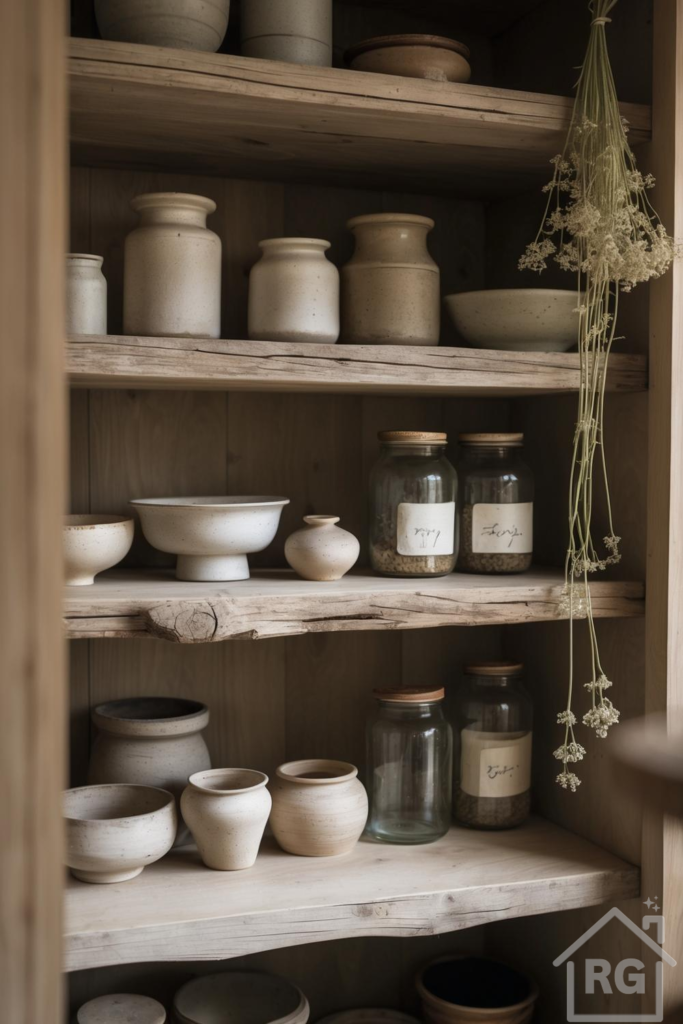
In a world often obsessed with flawless finishes, the Rustic Wabi-Sabi pantry offers a refreshing alternative – a space celebrating authenticity, natural materials, and the serene beauty of imperfection. It’s more than just storage; it’s a corner reflecting mindfulness and a connection to the natural world.
This aesthetic beautifully blends the rugged charm of rustic design with the Japanese philosophy of Wabi-Sabi, which finds beauty in transience and imperfection. If you’re drawn to earthy tones, tactile textures, and a sense of calm, this guide will show you how to create your own functional and soulful Rustic Wabi-Sabi pantry.
Understanding the Core Principles
Before diving into the specifics, let’s grasp the essence of this unique style:
- Rustic Elements: Think raw, unfinished materials, particularly wood with visible grain, knots, and even slight weathering. It evokes history, durability, and a connection to nature.
- Wabi-Sabi Philosophy: This embraces asymmetry, roughness, simplicity, economy, austerity, modesty, intimacy, and appreciation of the integrity of natural objects and processes. It’s about finding beauty in things that are imperfect, impermanent, and incomplete.
- Natural Materials: Wood, stone, ceramic, glass, linen, cotton, and dried botanicals are key. Synthetic materials are generally avoided.
- Earthy Palette: Colors are drawn directly from nature – muted tones like beige, cream, taupe, terracotta, stone grey, and various shades of brown and green.
- Functionality & Simplicity: While aesthetically pleasing, the pantry remains a practical space. Organization is achieved through simple, honest means rather than complex systems.
Step 1: The Foundation – Shelving and Structure
The shelves themselves set the stage. Opt for materials that embody the rustic feel:
- Reclaimed Wood: The ideal choice. Old barn wood, salvaged planks, or driftwood bring instant character and history. Look for pieces with interesting grain patterns, saw marks, or a naturally weathered patina.
- Rough-Sawn Lumber: If reclaimed isn’t feasible, choose new lumber with a rougher finish rather than perfectly smooth, planed boards. Pine, oak, or cedar can work well.
- Live Edge Shelves: Shelves that retain the natural edge of the tree trunk add a beautiful, organic element.
- Simple Construction: Avoid overly ornate brackets or supports. Simple metal brackets or hidden supports maintain the minimalist aesthetic. Consider a freestanding wooden shelving unit or built-ins constructed from rustic wood.
The finish should be minimal. A clear matte sealant can protect the wood without adding high gloss. Stains, if used, should be natural and enhance the wood grain rather than mask it. Sometimes, leaving the wood completely raw (if appropriate for the type and location) is the most authentic choice.
Step 2: Curating Your Containers
Storage is where the Wabi-Sabi philosophy truly shines. Choose containers that are functional, beautiful in their simplicity, and made from natural materials:
- Ceramic Jars & Crocks: Look for stoneware or earthenware pieces with matte or slightly textured glazes in neutral, earthy tones (cream, beige, grey, terracotta). Slight variations in shape, size, and glaze are desirable – they add character. Avoid brightly colored or perfectly uniform sets.
- Glass Jars: Simple glass jars (like Mason jars, Weck jars, or recycled food jars) are perfect for visibility. Opt for lids made of natural materials like cork or wood, or simple metal lids.
- Woven Baskets: Natural fiber baskets (seagrass, water hyacinth, rattan) add texture and are great for grouping smaller items or storing root vegetables.
- Wooden Boxes or Crates: Simple, unadorned wooden boxes can corral items or store produce.
Pro Tip: Resist the urge to buy everything new and matching. Mix and match different styles and sizes of containers for a more collected, organic look. Flea markets and antique shops can be great sources for unique ceramic pieces.
Step 3: Thoughtful Organization and Labeling
A Wabi-Sabi pantry is organized, but not rigidly so. The goal is accessibility and visual calm.
- Group Similar Items: Keep grains together, spices in one area, oils and vinegars nearby for intuitive use.
- Decant Staples: Transferring items like flour, sugar, pasta, and lentils into your chosen jars creates visual harmony and reduces packaging clutter.
- Simple Labeling (Optional): If you label, keep it minimal. Handwritten tags tied with twine, simple kraft paper labels, or erasable chalk labels maintain the aesthetic. Avoid overly stylized or plastic labels. Sometimes, the contents themselves are label enough.
- Embrace Space: Don’t overcrowd the shelves. Leaving some breathing room allows individual items to be appreciated and contributes to the feeling of calm.
Step 4: Incorporating Natural Textures and Decor
Texture is crucial for adding depth and interest. Beyond the wood and containers, consider:
- Dried Botanicals: A hanging bunch of dried herbs (like lavender, rosemary, or sage), dried flowers (like baby’s breath, statice, or grasses), or even seed pods adds a touch of nature and subtle aroma.
- Linen or Cotton Liners: If using baskets, simple, natural-colored fabric liners can add softness.
- Stone Elements: A small stone mortar and pestle or a slate cheese board used as a tray can introduce another natural texture.
- Handmade Touches: A hand-thrown ceramic bowl for fruit, a carved wooden scoop – items that show the maker’s hand fit perfectly.
Step 5: Palette and Lighting
Stick to a muted, earthy color palette derived from the materials themselves. The beauty comes from the interplay of textures and subtle variations in tone.
Lighting should be soft and warm. If your pantry has a window, maximize natural light. If not, consider warm-toned LED under-shelf lighting or a simple pendant light with a natural shade (ceramic, wood, woven material). Avoid harsh, cool fluorescent lighting.
Maintaining the Rustic Wabi-Sabi Pantry
This style is relatively low-maintenance, focusing on acceptance rather than constant polishing.
- Embrace Patina: Allow wood to age naturally and ceramics to show signs of use. Minor chips or variations add to the story and character.
- Regular Tidying: Keep surfaces clear and items generally in their place, but don’t strive for military precision. Focus on functional calm.
- Mindful Consumption: This aesthetic often encourages buying in bulk and reducing packaging waste, aligning with a more sustainable lifestyle.
Conclusion: Finding Serenity in Simplicity
Creating a Rustic Wabi-Sabi pantry is about more than just organizing food; it’s about curating a space that feels calm, grounded, and authentic. By focusing on natural materials, embracing imperfection, celebrating texture, and maintaining simplicity, you can transform a purely functional area into a small sanctuary within your home. It’s a beautiful reminder that true beauty often lies in the honest, the humble, and the perfectly imperfect.
